
Eadweard Muybridge was an English photographer known for his pioneering work in photographic studies of motion, and early work in motion-picture projection.

The Pit River is a major river draining from northeastern California into the state's Central Valley. The Pit, the Klamath and the Columbia are the only three rivers in the U.S. that cross the Cascade Range.

The Oahe Dam is a large earthen dam on the Missouri River, just north of Pierre, South Dakota, United States. Begun in 1948 and opened in 1962, the dam creates Lake Oahe, the fourth-largest man-made reservoir in the United States. The reservoir stretches 231 miles (372 km) up the course of the Missouri to Bismarck, North Dakota. The dam's power plant provides electricity for much of the north-central United States. It is named for the Oahe Indian Mission established among the Lakota Sioux in 1874.

Thomas Lincoln Casey Sr. was an American military and civil engineer of the late 19th century. He served as Chief of Engineers for the United States Army Corps of Engineers and oversaw the completion of the Washington Monument. American engineer Richard Weingardt wrote that Casey was the "U.S. Army Corps of Engineers’ most visible and celebrated builder of public buildings, monuments, and other significant works in the latter part of the 19th century."
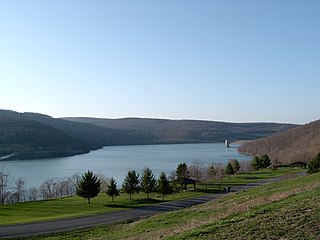
Jennings Randolph Lake is a reservoir of 952 acres (3.85 km2) located on the North Branch Potomac River in Garrett County, Maryland and Mineral County, West Virginia. It is approximately 8 miles (13 km) upstream of Bloomington, Maryland, and approximately 5 miles (8.0 km) north of Elk Garden, West Virginia.

Dworshak Dam is a concrete gravity dam in the western United States, on the North Fork of the Clearwater River in north central Idaho. In Clearwater County, the dam is located approximately four miles (6 km) northwest of Orofino and impounds the Dworshak Reservoir for flood control and hydroelectricity generation. By capacity, the reservoir is the largest in Idaho and fourth-largest in the Pacific Northwest.

Libby Dam is a concrete gravity dam in the northwestern United States, on the Kootenai River in northwestern Montana. Dedicated on August 24, 1975, it is west of the continental divide, seventeen miles (27 km) upstream from the town of Libby.

The McMillan Reservoir is a reservoir in Washington, D.C., that supplies the majority of the city's municipal water. It was originally called the Howard University Reservoir or the Washington City Reservoir, and was completed in 1902 by the U.S. Army Corps of Engineers.

Fairman Rogers was an American civil engineer, educator and equestrian. He worked as a professor of civil engineering at the University of Pennsylvania from 1855 to 1871 and as a trustee from 1871 to 1886. He was one of the founders of the Department of Mines, Arts and Manufactures and co-founded the School of Veterinary Sciences at the University.

Isabella Dam is an embankment dam located in the Kern River Valley, about halfway down the Kern River course, between the towns of Kernville and Lake Isabella in Kern County, California.
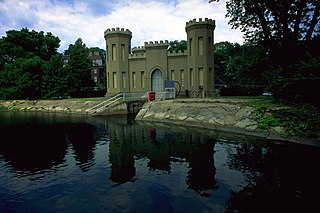
The Georgetown Reservoir is a reservoir that provides water to the District of Columbia. Part of the city’s water supply and treatment infrastructure, it is located in the Palisades neighborhood, approximately two miles downstream from the Maryland–D.C. boundary.

John Gross Barnard was a career engineer officer in the U.S. Army, serving in the Mexican–American War, as the superintendent of the United States Military Academy and as a general in the Union Army during the American Civil War. He served as Chief Engineer of the Army of the Potomac, 1861 to 1862, Chief Engineer of the Department of Washington from 1861 to 1864, and as Chief Engineer of the armies in the field from 1864 to 1865. He also was a distinguished scientist, engineer, mathematician, historian and author.
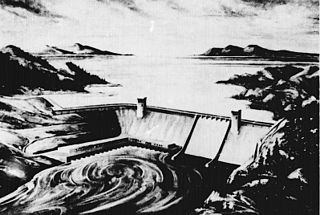
The Rampart Dam or Rampart Canyon Dam was a project proposed in 1954 by the U.S. Army Corps of Engineers to dam the Yukon River in Alaska for hydroelectric power. The project was planned for Rampart Canyon just 31 miles (50 km) southwest of the village of Rampart, Alaska, about 105 miles (169 km) west-northwest of Fairbanks.

Ocoee Dam No. 3 is a hydroelectric dam on the Ocoee River in Polk County, in the U.S. state of Tennessee. It is one of four dams on the Toccoa/Ocoee River owned and operated by the Tennessee Valley Authority, which built the dam in the early 1940s to meet emergency demands for electricity during World War II. The dam impounds the 360-acre (150 ha) Ocoee No. 3 Reservoir, which stretches 11 miles (18 km) upriver to the Tennessee-Georgia state line. Ocoee No. 3's powerhouse is actually located several miles downstream from the dam, and is fed by a 2.5-mile (4.0 km) conduit that carries water to it from the reservoir.

Howard A. Hanson Dam is an earthen embankment dam on the Green River, 21 miles (34 km) east of Auburn, Washington. The dam was completed in 1961 and its primary purpose is flood control along with water supply for Tacoma, Washington.
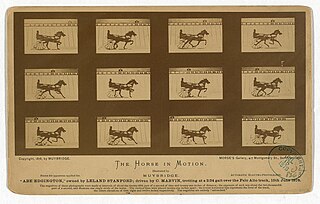
The Horse in Motion is a series of cabinet cards by Eadweard Muybridge, including six cards that each show a sequential series of six to twelve "automatic electro-photographs" depicting the movement of a horse. Muybridge shot the photographs in June 1878. An additional card reprinted the single image of the horse "Occident" trotting at high speed, which had previously been published by Muybridge in 1877.

Colonel Elmer Ellsworth Kirkpatrick, Jr., was a United States Army Quartermaster Corps and Army Corps of Engineers officer who worked on the Alaska Highway, the Canol project, and the Manhattan Project during World War II.

David Hillhouse Buel was a United States Army officer who rose to the rank of brevet major and lieutenant colonel in the Union Army during the American Civil War. Born in Michigan, he attended the United States Military Academy, and eventually became Chief of Ordnance of the Army of the Tennessee and fought in the First Battle of Bull Run. He was killed by a soldier at Fort Leavenworth, whom he had imprisoned for desertion.
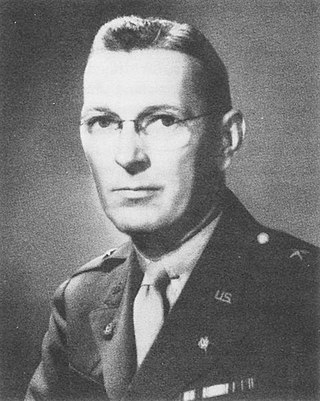
Brigadier General James Hobson Stratton was a United States Army officer who served in both World War I and World War II. Between the wars he was involved in the construction of the Conchas Dam and the John Martin Reservoir. During World War II he was the Chief of Engineering in the Office of Chief of Engineers and the Assistant Chief of Staff (G-4) of Communications Zone in the European Theater of Operations, United States Army (ETOUSA), the staff officer responsible for logistics planning. After the war he became a partner in Tippetts-Abbett-McCarthy-Stratton, a consulting engineering firm in New York, and directed the construction of the Tarbela Dam in Pakistan, the world's largest embankment dam, and the design of the Eisenhower Tunnel, the highest tunnel in the United States.

Animal Locomotion: An Electro-photographic Investigation of Consecutive Phases of Animal Movements is a series of scientific photographs by Eadweard Muybridge made in 1884 and 1885 at the University of Pennsylvania, to study motion in animals. Published in July 9, 1887, the chronophotographic series comprised 781 collotype plates, each containing up to 36 pictures of the different phases of a specific motion of one subject.




















